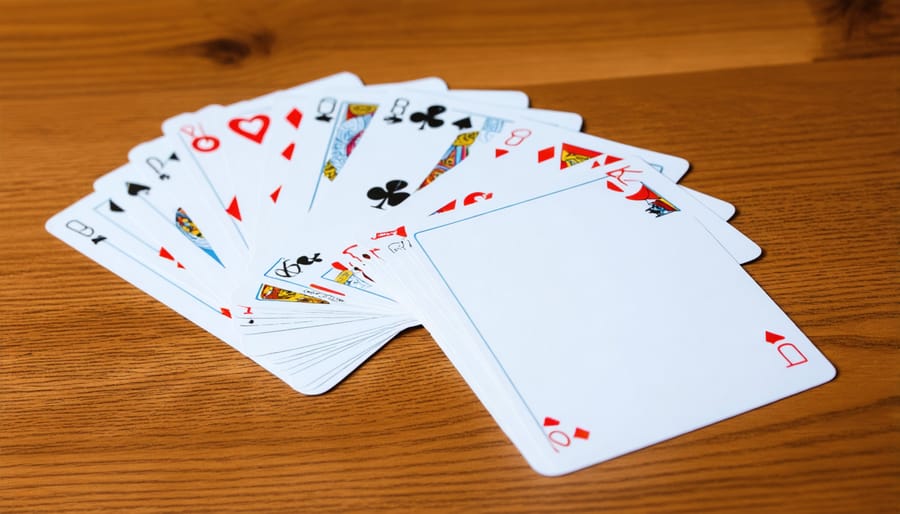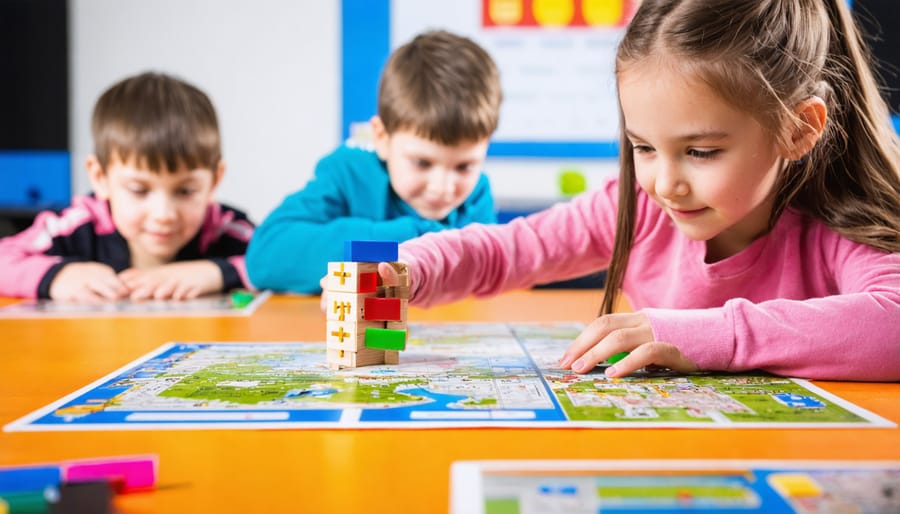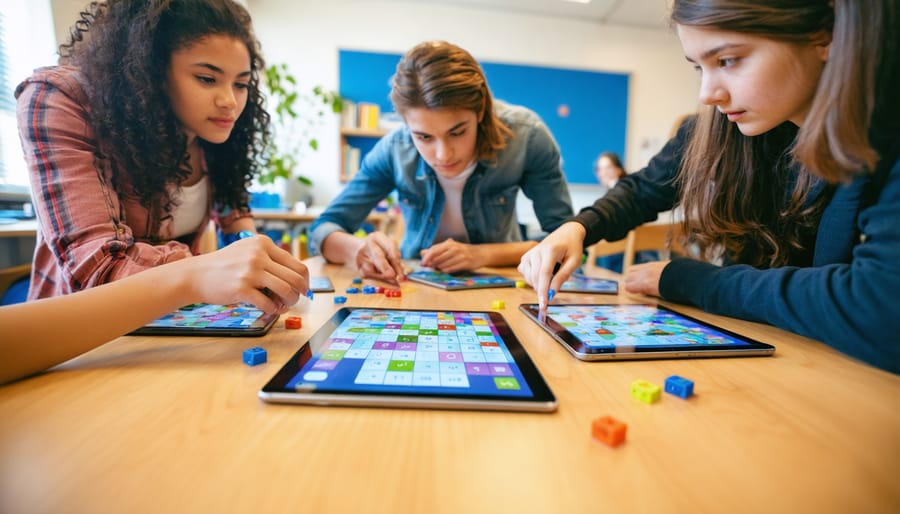These Game-Based Learning Examples Will Transform Your Classroom Tomorrow
Transform your classroom into an interactive learning space by exploring proven game-based learning examples that boost student engagement and retention. Whether you’re teaching elementary math or high school history, you’ll discover ready-to-implement options that match your curriculum goals and available resources.
Start with digital trivia games like Kahoot or Quizizz to review content before assessments, allowing students to compete individually or in teams while you track their progress in real-time. These platforms work perfectly with existing lesson plans and require minimal setup time.
Incorporate physical board game mechanics by creating customized Jeopardy-style reviews or escape room challenges that get students moving and collaborating. Use simple templates you can personalize with your own questions, making each game session relevant to your current unit.
Blend both approaches with hybrid activities where students use tablets or computers to solve digital puzzles that unlock physical challenges in the classroom. This combination keeps diverse learners engaged and addresses multiple learning styles simultaneously.
The best part? Most examples you’ll find are completely customizable to fit any grade level, subject area, or learning objective. You can adapt complexity, adjust time requirements, and modify rules based on your students’ needs. From quick five-minute warmups to full-period adventures, these practical examples give you flexibility while maintaining educational rigor. Get ready to see increased participation, improved knowledge retention, and genuine excitement about learning.
What Makes Game-Based Learning ‘Advanced’?
Let’s clear something up right away: advanced game-based learning isn’t about finding the flashiest digital game or the one with the coolest graphics. It’s about intentional, purposeful design that genuinely transforms how students learn.
The difference between basic and advanced game-based learning comes down to three key elements. First, there’s purposeful design. Instead of dropping a random game into your lesson plan because it looks fun, you’re selecting or creating games that directly address specific learning objectives. You know exactly which standards you’re targeting and how the game mechanics reinforce those skills.
Second, advanced approaches integrate meaningful assessment. You’re not just watching students have fun—you’re gathering real data about their understanding. This means building in checkpoints, tracking progress, and using game results to inform your instruction. The game becomes a window into student thinking, not just a break from “real learning.”
Third, differentiation is baked right in. Advanced game-based learning recognizes that your students have different needs, skill levels, and learning preferences. You’re customizing difficulty levels, offering multiple pathways to success, and ensuring every student can access the content meaningfully.
Here’s what this looks like in practice: Instead of using a vocabulary matching game once for fun, you design it with tiered difficulty, track which words students struggle with, and use that data to form small groups for targeted practice. The game drives student engagement while simultaneously providing you with actionable insights.
Advanced doesn’t mean complicated—it means thoughtful, strategic, and results-oriented. You’re using games as powerful teaching tools, not just entertaining time-fillers.

Digital Game Templates That Actually Work
Jeopardy-Style Review Games
Transform your test prep into an exciting game show experience with Jeopardy-style review games! This classic quiz format gets students energized about reviewing material while building confidence before assessments.
The beauty of Jeopardy games lies in their flexibility. You can create them using free templates online, PowerPoint presentations, or even a simple whiteboard grid. Organize content by categories that match your curriculum—for example, a math teacher might use “Fractions,” “Geometry,” and “Word Problems,” while a history teacher could feature different time periods or themes.
Here’s a quick customization tip: adjust point values to reflect difficulty levels that match your students’ abilities. For younger learners, use smaller numbers like 100-500, while older students can handle 200-1000 point spreads.
Make it more engaging by letting students work in teams, encouraging collaboration and discussion. You can also add a “Daily Double” element where teams can wager points, raising the stakes and excitement.
Subject-specific applications work brilliantly across disciplines. Science teachers can review vocabulary and concepts, language arts teachers can focus on literary elements, and foreign language classes can practice vocabulary and grammar. The competitive yet supportive atmosphere helps students retain information while having fun together.
Escape Room Challenge Templates
Transform your classroom into an immersive adventure with escape room challenges that get students thinking critically while having a blast! These puzzle-based games work beautifully across all subjects and grade levels.
Start simple by creating themed rooms tied to your curriculum. For math classes, design number puzzles where students solve equations to unlock the next clue. In history, hide facts about historical events that students must piece together chronologically. Science teachers can build challenges around the scientific method, requiring students to test hypotheses to progress.
The beauty of escape rooms is their flexibility. You can run them physically in your classroom using locked boxes and hidden clues, or create digital versions using Google Forms with branching logic. Mix and match puzzle types including riddles, ciphers, pattern recognition, and logic problems to accommodate different learning styles.
Keep setup manageable by starting with three to five interconnected puzzles. Use everyday materials like combination locks, QR codes, and envelopes. Students work in small teams, naturally developing collaboration and communication skills while racing against the clock. The competitive element keeps energy high and engagement even higher, making challenging content feel like pure fun rather than traditional learning.
Interactive Board Game Formats
Remember those classic board games you loved as a kid? Now imagine bringing that same excitement into your classroom with digital twists! Classroom board games have gone digital, and they’re perfect for review sessions that students actually look forward to.
Popular formats include Jeopardy-style quiz games, Bingo variations with academic content, and race-to-the-finish game boards where students advance by answering questions correctly. You can easily customize these templates with your own content, whether you’re reviewing multiplication facts, vocabulary words, or historical events.
The beauty of digital board game formats is their flexibility. You can project them on your smartboard for whole-class participation, assign them for small group work on tablets, or even send them home for independent practice. Many templates allow you to adjust difficulty levels, add bonus rounds, or incorporate multimedia elements like images and sound effects.
Best of all, setup takes just minutes. Simply plug in your review questions, choose your game format, and you’re ready to transform test prep into an engaging experience that builds confidence and reinforces learning naturally.
Physical Games That Build Deep Learning

Card-Based Learning Systems
Card games offer a fantastic way to turn learning into friendly competition! You can use traditional playing cards or create custom decks tailored to your curriculum. For math practice, games like “Make 10” challenge students to combine cards reaching target numbers, building mental calculation skills naturally. Flash card battles work brilliantly for multiplication tables—students flip cards simultaneously, and whoever correctly answers first wins both cards.
Create matching games where students pair vocabulary words with definitions, historical dates with events, or fractions with decimals. These vocabulary and spelling games become even more engaging when you add strategic elements like “steal a pair” or “trade cards” rules.
The beauty of card-based learning lies in customization. Simply print concepts onto cardstock, laminate them, and you’ve got reusable learning tools. Students can even design their own card decks as review activities, deepening their understanding while creating games for classmates.
Try incorporating popular game mechanics like “Go Fish” for category matching or “War” for comparing numbers, fractions, or vocabulary difficulty levels. These familiar formats reduce learning curves, letting students focus on content mastery while enjoying gameplay that feels recreational rather than drill-focused.
Role-Playing Simulations
Role-playing simulations bring learning to life by placing students directly into historical events, scientific scenarios, or real-world social situations. These immersive experiences let learners make decisions, face consequences, and develop deeper understanding through active participation.
For history classes, try simulations where students become historical figures during key moments like Constitutional debates or ancient civilizations. Students research their assigned roles, then interact authentically based on their character’s beliefs and motivations. This approach transforms passive reading into memorable experiences where they truly grasp different perspectives.
Science comes alive when students role-play as researchers solving environmental problems or doctors diagnosing patients. They apply scientific concepts in realistic contexts, learning problem-solving skills alongside content knowledge. The beauty here is customization—adjust complexity levels to match your grade level and learning objectives.
Social-emotional learning flourishes through conflict resolution scenarios and community-building simulations. Students practice empathy, communication, and decision-making in safe environments where mistakes become teaching moments. Start simple with 15-minute scenarios, then build up to longer experiences as students gain confidence. The key is making roles clear, providing enough background information, and facilitating meaningful reflection afterward to cement learning.
Movement-Based Learning Games
Get your students moving while they learn with these energizing classroom activities! Movement-based games combine physical activity with content review, making learning memorable and fun.
Try Quiz Relay Races where students run to answer questions posted around the room, or Four Corners where each corner represents a different answer choice. Students move to their selected corner, then discuss their reasoning with classmates. Scavenger Hunts work brilliantly for any subject—hide math problems around the playground or vocabulary words throughout the building.
Simon Says with a twist lets you reinforce any concept: “Simon says touch something that’s a noun” or “Simon says make a right angle with your arms.” For younger learners, Action-Based Alphabet activities combine letter recognition with jumping jacks or animal movements.
The beauty of movement games? They’re incredibly customizable. Adjust difficulty levels, change content instantly, and adapt for any grade level or learning objective. Plus, they require minimal prep and zero technology. Your students will be so engaged in moving and playing, they won’t even realize how much they’re learning!
Hybrid Games That Combine Digital and Physical Elements

Scavenger Hunts with Digital Checkpoints
Transform your classroom into an adventure zone with scavenger hunts that blend physical movement with digital tracking! This approach gets students out of their seats while using presentation software as a dynamic checkpoint system.
Here’s how it works: Create a presentation slide deck where each slide represents a station or challenge location around your classroom or school. Students move from station to station, solving puzzles, answering questions, or completing tasks. When they finish each challenge, they click to the next slide, which reveals their next destination and clue.
The beauty of this method is its incredible flexibility. You can customize hunts for any subject—math problems leading to numbered stations, vocabulary words directing students to labeled areas, or historical facts guiding them through a timeline posted around the room. Add QR codes at physical stations that link to specific slides for extra tech integration.
Track student progress by having teams use tablets or shared devices, or display the master presentation on your screen while students report their findings. Include point systems, time challenges, or bonus riddles on certain slides to amp up the excitement. Students stay engaged because they’re moving, collaborating, and racing toward a goal—all while learning your content objectives naturally and enthusiastically!
Team Competition Formats
Team competition formats bring exciting energy to your classroom while building essential collaboration skills! These activities combine the motivational power of scoreboards with meaningful problem-solving tasks that get students working together toward common goals.
Start by dividing your class into small teams of 3-5 students. Display a simple scoreboard at the front of your room tracking team points throughout the week. Award points for completing challenges like solving multi-step math problems, conducting science experiments, or creating group presentations. The visible scoreboard creates healthy competition that keeps motivation high.
Try relay-style challenges where each team member completes one part of a larger task before passing it to the next person. This works beautifully for everything from grammar exercises to coding challenges. You can also use quiz bowl formats where teams buzz in to answer questions, earning points for correct responses.
The customization possibilities are endless! Adjust point values to emphasize different skills, create bonus rounds for creative thinking, or offer power-ups teams can earn. Consider weekly tournaments where winning teams get small privileges like choosing seating arrangements or picking the next class activity.
Mix up team compositions regularly so students collaborate with different classmates, building inclusive classroom communities while maintaining that fun competitive spirit everyone loves!
Making Games Work for Different Grade Levels
The secret to successful game-based learning? Meeting students exactly where they are! The same game can work brilliantly across different grade levels when you apply smart customization techniques.
For elementary students, focus on simplicity and visual appeal. Take a digital quiz game and add colorful characters, simple vocabulary, and immediate rewards like stars or badges. Physical games work wonderfully too—think math bingo with larger numbers and pictures, or vocabulary memory matches with image clues. Keep rounds short (5-10 minutes) to match shorter attention spans, and build in movement opportunities whenever possible.
Middle schoolers thrive on competition and social interaction. Amp up the challenge by introducing team-based formats, point systems, and leaderboards. They love games that let them collaborate or compete with classmates. Add complexity to content—swap basic multiplication for algebraic expressions, or transform simple trivia into scenario-based challenges. These grade-specific strategies help keep preteens engaged while building critical thinking skills.
High school students need sophistication and real-world connections. Transform games into simulations that mirror actual scenarios—economic market games, historical decision-making adventures, or scientific experiments with consequences. Give them choices and autonomy within the game structure. They appreciate deeper strategic thinking and longer, more complex gameplay that extends over multiple class periods.
The winning formula across all levels? Start with clear learning objectives, then customize difficulty, complexity, and presentation style. Adjust vocabulary, increase or decrease collaboration requirements, and modify time constraints based on your students’ developmental stage. Don’t be afraid to let students help design variations—they often know exactly what will keep them motivated and learning!
Quick Implementation Tips for Busy Teachers
Let’s be real—you’re busy! Between lesson planning, grading, and everything else on your plate, adding games might feel like one more thing to juggle. But here’s the good news: game-based learning doesn’t have to eat up your prep time.
Start by choosing your timing strategically. Games work brilliantly as review sessions before assessments, making test prep feel less stressful for students. They’re also perfect for those tricky last 10 minutes of class when attention spans are fading, or as engaging warm-up activities that get brains firing on all cylinders.
For minimal-prep options, lean on games with built-in flexibility. Digital platforms like Kahoot or Quizizz let you search existing question sets instead of building from scratch. For physical games, keep a template library ready—think blank bingo boards, game show-style answer cards, or simple board game formats you can customize with any content in minutes.
Here’s a time-saver that really works: let students create game content. Have them write quiz questions, design challenge cards, or develop puzzles for classmates. You’re getting peer teaching benefits while cutting your prep time in half.
For assessment, skip the extra paperwork. Observe during gameplay and use quick documentation methods like photos of student work, voice-recorded notes on your phone, or simple exit tickets asking students to explain one strategy they used. Many digital games automatically track performance data, giving you instant insight into who’s mastering concepts and who needs support.
Remember, games don’t need to be elaborate to be effective. A five-minute vocabulary relay race or quick think-pair-share challenge counts as game-based learning. Start small, customize what works for your classroom, and watch student engagement soar without sacrificing your precious planning time.
Ready to bring more play into your classroom? Here’s the best news: you don’t need to overhaul your entire teaching approach or master complicated technology to get started with game-based learning. The most successful implementations often begin with simple, small steps.
Choose just one example from this article that resonates with your teaching style and upcoming lesson plans. Maybe it’s adding a quick quiz game to review vocabulary, transforming your next assessment into a choice board adventure, or trying a five-minute movement-based game before a challenging concept. The key is starting somewhere rather than waiting for the perfect moment or the perfect game.
Remember, game-based learning is incredibly flexible and customizable to fit your unique classroom needs. That digital scavenger hunt can work just as well with paper clues. Your board game review doesn’t need fancy pieces—index cards and dice work wonderfully. Give yourself permission to experiment, adapt, and even fail forward as you discover what engages your students most.
Your students are already natural game players. By meeting them in this familiar space, you’re not just making learning more enjoyable—you’re making it more effective and memorable. So pick one strategy, try it in your next lesson, and watch how quickly your students lean in. You’ve got this, and your classroom is about to get a whole lot more exciting.


